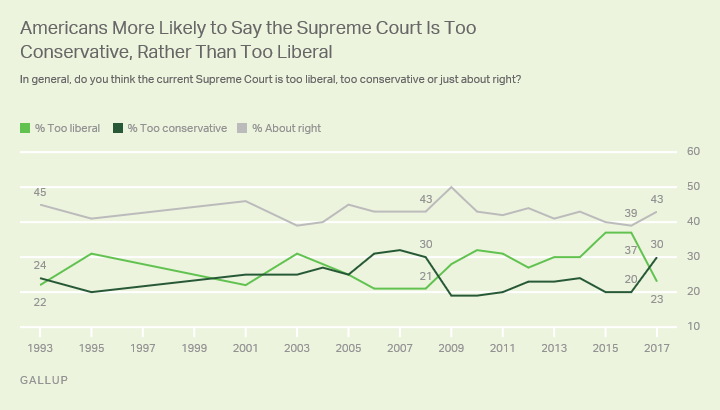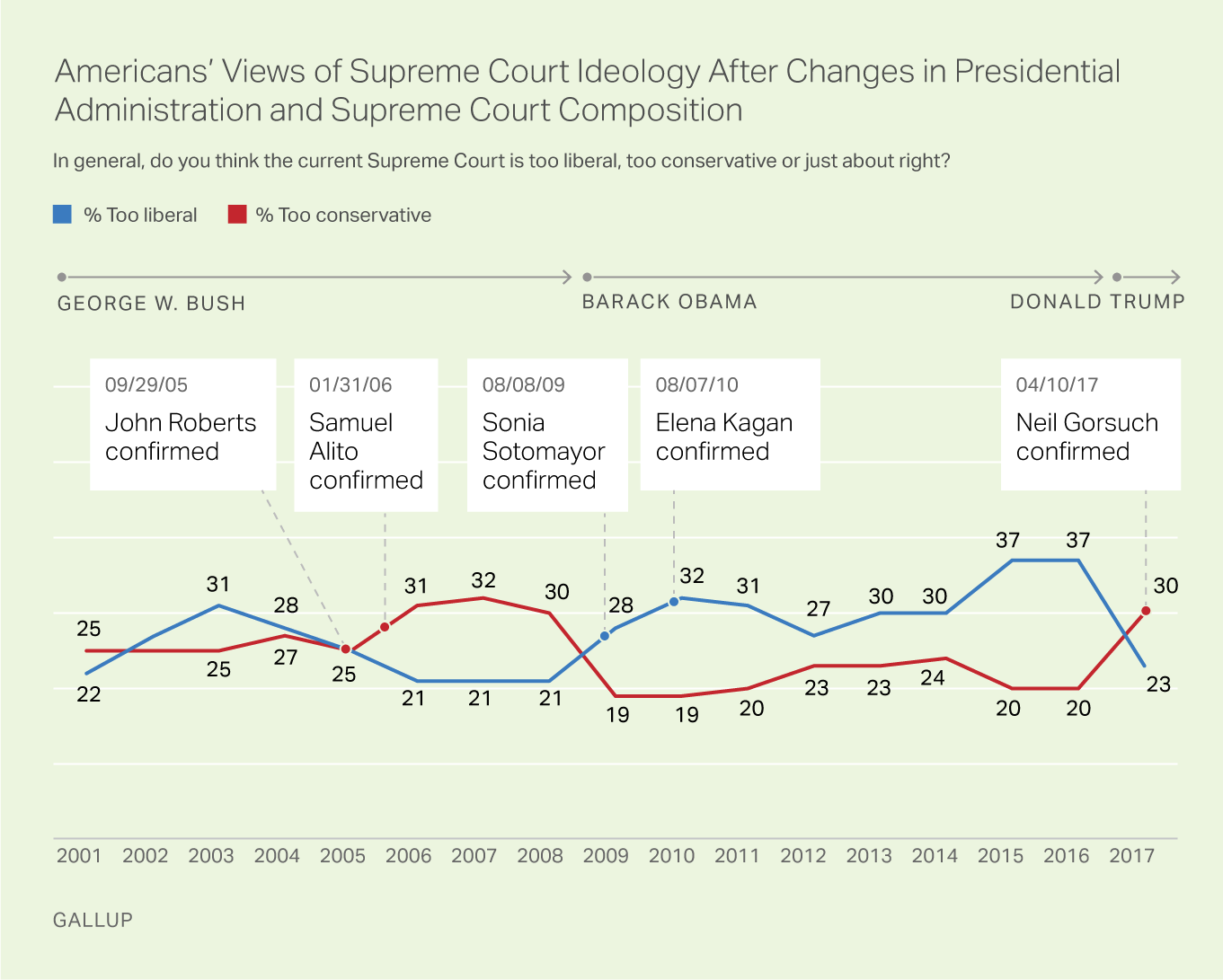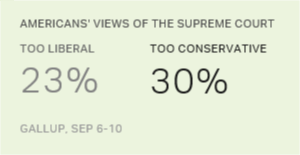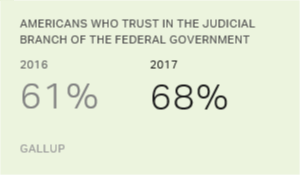Story Highlights
- 30% of Americans say the Supreme Court is too conservative
- 23% say the court is too liberal
This story is part of a series focusing on Americans' confidence in various types of government and their views of the political parties and of the role and power of government. Follow the series on our Government topic page.
WASHINGTON, D.C. -- For the first time in nearly a decade, more Americans say the Supreme Court is too conservative (30%) than too liberal (23%). These views are reversed from last year, when 37% said the court was too liberal and 20% too conservative. Overall, the most popular view is that the Supreme Court's ideology is "about right" (43%).

These data are from Gallup's annual Governance Poll, conducted Sept. 6-10. The shift toward the court being viewed as "too conservative" comes as Republicans control the White House, both houses of Congress and have ideological allies in five of the nine Supreme Court justices.
While more Americans now say the court is too conservative than too liberal, the seven-percentage-point gap is smaller than the 17-point gaps in 2015 and 2016 when many more thought the court was too liberal than too conservative. The relatively strong perception in those two years that the court was too liberal likely stemmed from the court upholding the constitutionality of same-sex marriage and the Affordable Care Act (ACA) in June 2015.

Subscribe to our online platform to access nearly a century of data.
Gallup Analytics lets you search, compare and export data to enhance your research.
Since Gallup first measured perceptions of the court's ideology in 1993, Americans have said the court is too liberal rather than too conservative 11 out of the 18 times the question has been asked. Across this period, an average 28% called the court too liberal while 24% called it too conservative.
Perception of Court Likely Influenced by President's Party, Justices
Shifts in Americans' perceptions of the ideological leaning of the court suggest these views are likely influenced by the current president's political party and the justices they appoint. During George W. Bush's first few years in office, from 2001 to 2005, Americans were roughly divided over whether the court was too liberal or too conservative. In 2006, at the same time Bush's approval rating had slumped into the 30s, but also after his two Supreme Court nominees -- John Roberts and Samuel Alito -- were confirmed, more Americans saw the court as too conservative, and that continued through 2008.
Gallup's first measure of the court's ideology during the Barack Obama administration, in late August/early September 2009, found a shift toward more Americans calling the court too liberal than too conservative. Because the poll was conducted after Obama had already nominated his first Supreme Court justice, Sonia Sotomayor, in May 2009, it is unclear whether Obama's presidency or his appointment of left-leaning Sotomayor was the catalyst for the change. However, Gallup found no meaningful shift in views after Obama appointed another left-leaning justice, Elena Kagan, in 2010. It wasn't until 2015, following the court's same-sex marriage and ACA rulings earlier that year, that the proportion calling the court too liberal increased further.
The latest measure under Donald Trump, the first since he took office and after his nominee for the court, Neil Gorsuch, was sworn in, finds a switch back to more Americans calling the court too conservative.

Bottom Line
Americans' perceptions of the political leanings of the Supreme Court are likely influenced by the party of the president in power, high-profile court decisions and, potentially, by the justices the president appoints. During the years of George W. Bush's presidency, Americans were more likely to say the court was too conservative, especially after he made his two Supreme Court nominations -- while under Obama, Americans were consistently more likely to say the institution was too liberal.
This pattern of perceptions of the court being aligned with the party of the president has continued so far under Trump. Should Trump be in a position to replace a liberal justice with a conservative one, Americans may become even more likely to believe the court is too conservative.
Survey Methods
Results for this Gallup poll are based on telephone interviews conducted Sept. 6-10, 2017, with a random sample of 1,022 adults, aged 18 and older, living in all 50 U.S. states and the District of Columbia. For results based on the total sample of national adults, the margin of sampling error is ±4 percentage points at the 95% confidence level. All reported margins of sampling error include computed design effects for weighting.
Each sample of national adults includes a minimum quota of 70% cellphone respondents and 30% landline respondents, with additional minimum quotas by time zone within region. Landline and cellular telephone numbers are selected using random-digit-dial methods.
View survey methodology, complete question responses and trends.
Learn more about how the Gallup Poll Social Series works.




